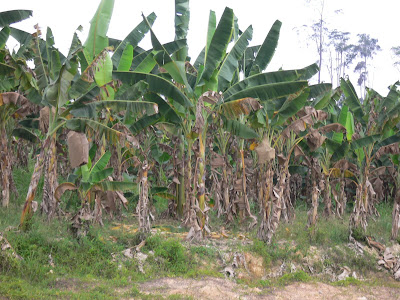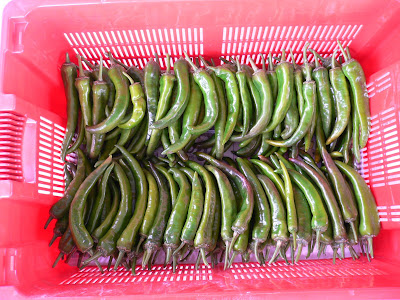Thursday, September 25, 2008
Quality, function and benefits of Fine Compost
1. Pathogen Bacteria - Free
2. Eggs and Parasite - Free
3. Weed seeds - Free
4. Plant Toxic - Free
5. Odour - Free
Function of Fine Compost
1. Stimulate growth
2. Condition soil
3. Enhance soil porosity
4. Intensify soil aggregate
5. Improve soil premeability
6. Enhance water hold capacity
7. Increase land productivity
Benefits of Fine compost
1. Cut the cost fertilizer
2. Improve biological soil fertility
3. Enhance soil physicality (texture, structure, etc)
4. Improve soil pH
5. Supply soil micro and macro nutrient
6. Economical and easy to use
7. Healthier plants, remorse from insect, fungus and diseases
8. Enhance land productivity
9. Increase production quantity and quality
10. Good effects for the environment
Wednesday, September 24, 2008
Fine Compost: High Quality Organic Fertilizer
Stable supply of organic fertilizer both on quantity and quality consistency is an exacting challenge. Lembah Hijau Multifarm Research Station has succeeded to innovate organic waste management system (farming). This organic waste is transformed into high quality organic fertilizer, which is called "Fine Compost".
Green Valley Fine Compost is processed with decomposition method using Stardec starter microbe, which is tested since 1981 through its application on plantation, horticulture and nursery.
Fine Compost production system make uses of Stardec starter microbe and has been recomended by the Ministry of Agriculture of Indonesia, certified by BINUS and patented under the law of the Departemen Kehakiman dan HAM Republic of Indonesia.
Content of Fine Compost:
Total N 1.81%
P2O5 1.89%
K2O 1.96%
CaO 2.96%
MgO 0.70%
C/N Max 20%
pH 6.5-7.5
Cation exchange capacity >75me/100gram
Moisture 40+5%
Seedling experiment Acceptable
Pathogenic Microorganism Free
Thursday, August 28, 2008
Wednesday, August 27, 2008
We use SAMPI ! ! !
- Is an organic fertilizer, soil biology feed and revitaliser produced from fresh tuna
- Is 100% pure liquid fish & contains a wide spectrum of major nutrients and trace elements in organic plant available form
- Retains all the nutrients, trace elements, vitamins etc. that were present in the raw fish and is very effective as a livestock feed additive
- Can be used as a foliar spray and also for ground application
- Has a non-offensive smell, is easy to handle and simple to apply by spray equipment & fertigation
- Is suitable for all soils, pastures, crops, ornamentals, trees and vegetables
- Is environmentally friendly and safe to plants
Raw material used: Australian Processed wild caught Tuna. We do not use fresh water or aquacultured fish or northern hemisphere species which may contain toxins.
Process: Fresh Tuna material is received fresh daily at our factory in Port Lincoln, South Australia. It is ground and then enzyme digested in a low temperature process which breaks down fish, or fish frames to simpler protein complexes. No synthetic materials are mixed into the fish hydrolysate, and the only manipulation the product undergoes is grinding and hydrolysis. This process yields a stable, non-odorous, liquid slurry which can be separated into solute, solids and oil, is compleatly safe and has been certified as organic.
Advantages: Tuna hydrolysate is a totally natural product having not been subjected to high heat or chemical treatment, and contains many trace elements including selenium. It is a soil rather than a plant food or fertiliser. It contains nutrients that feed the good bacteria and fungi in soil where the nitrogen drawing activities and nutrient excreted by the bacteria ensure sustainable, healthy plant growth.
It's gettin hot!
Tuesday, August 26, 2008
Tuesday, August 19, 2008
Keadaan tanaman di ladang
Sehari di MAHA 2008
MAHA 2008 yang bermula pada pukul 10.30 itu sudah pun menerima pengunjung yang ramai sejak pagi lagi, dari budak-budak sekolah dan kolej ke penduduk sekitar Kuala Lumpur dan Lembah Klang. Bayaran bagi parking adalah RM5, agak mahal tapi rasanya, sudah pun diturunkan pada minggu cuti sekolah ini, bagi tidak membebankan mereka yang berkeluarga untuk datang. Pengunjung juga dikenakan charge sebanyak RM1 untuk menaiki perkhidmatan tram yang membawa mereka pusing satu kawasan MAHA. Kalau nak berjalan memang lah tak larat!
MAHA 2008






























